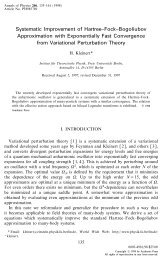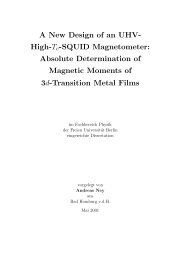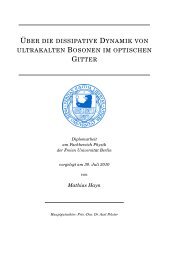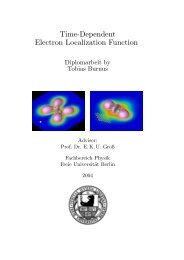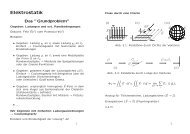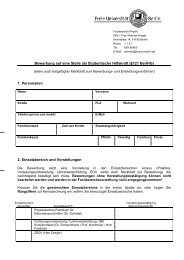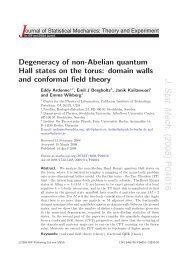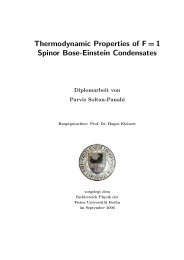Technical University Kaiserslautern Preprint - Fachbereich Physik ...
Technical University Kaiserslautern Preprint - Fachbereich Physik ...
Technical University Kaiserslautern Preprint - Fachbereich Physik ...
Create successful ePaper yourself
Turn your PDF publications into a flip-book with our unique Google optimized e-Paper software.
4<br />
(a)<br />
FIG. 2. Linear stability diagrams for (a) unstable and (b)<br />
stable equilibria of an isotropic BEC. Shaded and white regions<br />
indicate stable and unstable solutions, respectively. The<br />
presence of a stable region in (a) indicates that an originally<br />
unstable equilibrium might be stabilized by parametric excitation.<br />
(b)<br />
The results for the originally stable equilibrium u 0+<br />
show both qualitative and even quantitative similarity<br />
to the linear stability analysis of Fig. 1, i.e., a similar<br />
tonguelike structure of unstable regions issuing from certain<br />
points on the vertical axis. The originally unstable<br />
equilibrium u 0− also shows qualitative similarity to the<br />
linear analysis of Fig. 1, however the region of stability<br />
begins only for much larger modulation frequency Ω<br />
and dimensionless driving amplitude p 1 . These results<br />
are both reasonable, as the linear stability analysis is<br />
only valid for small oscillations – corresponding to large<br />
(p 1 ,Ω) for equilibrium u 0+ and small (p 1 ,Ω) for equilibrium<br />
u 0− . Furthermore, in contrast to Fig. 1, we find<br />
in the nonlinear stability diagram of Fig. 3 that stability<br />
is more easily achieved for a cigar-shaped BEC, i.e., for<br />
λ < 1.<br />
Further comparison of the linear and nonlinear stability<br />
diagrams of Figs. 1 and 3 shows the possibility of<br />
both simultaneous stability of the equilibrium positions,<br />
and even the possibility of a complete reversal of the<br />
stability characteristics. In the latter case, the smaller<br />
equilibrium position would become the only stable width<br />
of the condensate, which should be experimentally observable.<br />
A final observation, applicable to the originally<br />
unstable equilibrium in both linear and nonlinear<br />
cases, is the existence of a minimum driving amplitude<br />
p min<br />
1 necessary to stabilize the condensate. The value<br />
p min<br />
1 = u 0 (5u 4 0−1) ≈ 0.17 p 0 is exactly attainable for the<br />
linearanalysisoftheisotropiccondensate, andinFig.1is<br />
approximately independent of λ in the considered range<br />
[0.2,2.6]. For the nonlinear analysis, p min<br />
1 ≈ 1.2 p 0 is also<br />
approximately independent of λ. This feature will have<br />
implications for an experiment, as in conjunction with<br />
the width of the Feshbach resonance, it dictates the minimum<br />
modulation of the applied magnetic field necessary<br />
to stabilize the condensate.<br />
(c)<br />
FIG. 3. Nonlinear stability diagrams for the unstable (left)<br />
andstable(right)equilibriaofacylindrically-symmetricBEC,<br />
for three values of the trap anisotropy λ: (a) λ = 0.2 (a cigarshaped<br />
BEC), (b) λ = 1 (spherical BEC), and (c) λ = 2.6<br />
(pancake BEC).<br />
Wenotethatanystabilitydiagramdependsontheparticular<br />
choice for the time-averaged dimensionless interaction<br />
strength p 0 . The concrete resultsin Figs. 1–3were<br />
obtained for the particular value p 0 = 0.9 p crit<br />
0 (λ). As p 0<br />
approaches p crit<br />
0 (λ), we generically observe a growth of<br />
the stable (unstable) regions in case 1 (2).<br />
Finally, we conclude that our proof-of-concept investigation<br />
has unambiguously shown that the phenomenon<br />
ofparametricresonanceshouldbeexperimentallyobservable<br />
also for Bose-Einstein condensation. However, due<br />
to the intrinsic nonlinear nature of the underlying GP<br />
mean-field theory, a linear analysis, like in the Paul trap,<br />
is not sufficient to quantitatively study the stability diagram.<br />
Thus, in order to achieve a destabilization (stabilization)<br />
of a stable (unstable) BEC equilibrium in an<br />
experiment, a corresponding numerical nonlinear analysisisindispensable.<br />
Regardless,alinearstability analysis<br />
providesanintuitiveandqualitativeunderstandingofthe<br />
physics of parametric resonance in BECs.<br />
In the present letter we have focused our attention<br />
upon a periodic modulation of the s-wave scattering<br />
length around a slightly negative value, which restricts




